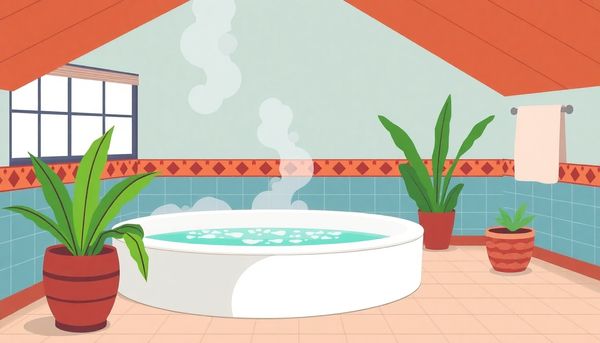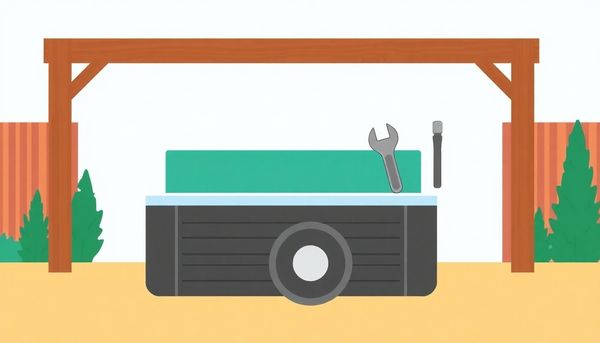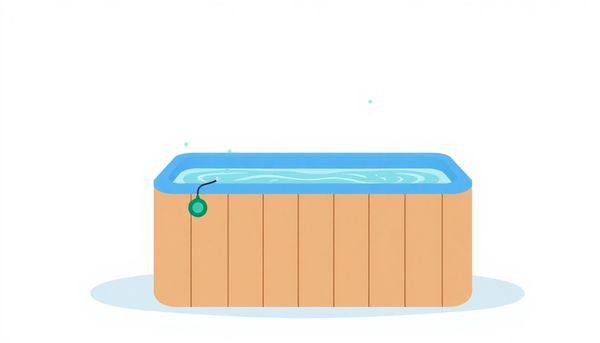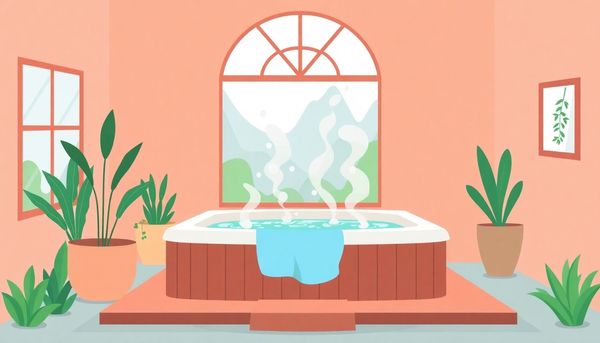Understanding Spa Blowers: Essential Guide to Hot Tub Maintenance
July 30th, 2024
July 30th, 2024
A spa blower might seem like a mysterious component to those unfamiliar with the inner workings of hot tubs. However, understanding its function is as refreshing as a dip in your favorite whirlpool. The spa blower is the unsung hero that breathes life into the bubbles, turning a simple soak into a luxurious, effervescent escape. Without it, you might find your spa experience a bit flat.
Years ago, while trying to unwind after a long week, I noticed my spa had lost its signature fizz. A quick investigation led me to the spa blower, a small yet mighty device responsible for injecting air into the water. At that moment, I realized that maintaining this component is as crucial as keeping the water warm. It’s not just about replacing a broken part; it’s about preserving the serenity of your personal oasis.
Understanding how to repair and replace a spa blower can save both time and money. Whether it’s the occasional rattling noise or a complete silence from the jets, knowing how to address blower issues ensures your spa remains a sanctuary. Skills like detecting malfunctioning parts and executing a smooth replacement process can transform you from a frustrated spa owner to a confident do-it-yourself repairer. In this guide, you'll discover how to restore your spa's bubbly charm, turning every soak into a rejuvenating retreat.

Finding yourself staring at a stubbornly silent hot tub can be an unexpected twist to your relaxing evening plans. The likely culprit? A faulty spa blower. Recognizing this issue doesn't require a degree in engineering, but a bit of detective work can certainly help. Start by listening closely—if the blower is silent, it's a major red flag. Another clear sign is if the blower hums but fails to push air through the jets. This could indicate a seized motor or a burnt-out component within the blower.
Visual inspection is also key. Look for any obvious signs of wear, such as cracks or breaks in the blower housing. Also, examine the blower’s wiring; any frayed or burned wires might suggest electrical issues. It’s as simple as noticing the little things that might be out of place.
Check if the blower is receiving power. Use a multimeter to test the voltage at the blower’s terminals. No power? Start tracing back to find the fault—perhaps a tripped breaker or a blown fuse. If power is present and the blower remains unresponsive, you’re likely dealing with a mechanical failure inside the blower itself.
To top it off, ensure the blower’s air channels are free of obstructions. Blockages can occur, restricting airflow and causing the system to underperform. By identifying these symptoms, you’re one step closer to reclaiming your spa bliss. This methodical approach saves time and helps you decide whether a simple fix or a full replacement is in order.
A spa day at home can quickly lose its charm when the jets refuse to bubble. Often, the culprit is the spa blower, that unsung hero responsible for creating those delightful bubbles. Knowing the common issues with this component can be a game changer, sparing you both frustration and unnecessary expenses.
First, consider the silence. If your blower doesn’t hum when switched on, it might be an electrical issue, such as a tripped circuit breaker or a blown fuse. Before reaching for tools, ensure that power is reaching your spa. Once, after a particularly windy night, I found my own hot tub silent because of a tripped breaker. A simple flick of the switch brought back the blissful bubbling.
Vibrations or unusual noises signal another common problem. This could mean a misalignment in the blower's motor mount or wear and tear in the bearings. A quick inspection can reveal if tightening or replacement is needed. On one occasion, a persistent rattle turned out to be a loose mounting bolt—a simple fix with a screwdriver.
Lastly, weak or intermittent airflow often points to blockages in the air path. Leaves and small debris might find their way into the system, especially if your spa is outdoors. A regular maintenance routine, involving a gentle cleaning of the air intake, can prevent this common hiccup.
By staying alert to these issues, you can ensure your home spa remains a sanctuary of relaxation, not a source of stress.
On a chilly evening, the anticipation of warm bubbles can quickly turn into frustration when the hot tub's soothing jets refuse to cooperate. In the realm of spa blower dilemmas, replacing the unit often triumphs over repairing it. Unlike tangled knots in a yarn ball, untangling the intricate issues within a spa blower motor isn't always cost-effective or straightforward. The allure of a quick repair can be misleading, as internal parts might be too worn, obscure, or intricate to justify the effort.
Consider, for example, the scenario of a friend who recently faced a blower malfunction. After weighing the options, she opted to replace the entire assembly, sparing herself the agony of repeated fixes and uncertain outcomes. With a few tools and the right replacement, she transformed her spa from a silent basin back to its bubbly haven. By ensuring the new blower matched her hot tub's electrical specifications, she guaranteed an easy installation process.
Furthermore, modern spa blowers come equipped with features that enhance performance and durability, such as noise-reducing rubber motor mounts. These new additions can significantly improve the overall hot tub experience, making replacement a worthwhile investment. Ultimately, while repairs may tempt the industrious, opting for a replacement can be the wisest move, returning you swiftly to a world of warmth and relaxation.
Safety should always be your top priority, especially when dealing with water and electricity—two elements that don't mix well. Working on a spa blower demands a meticulous approach to avoid any mishaps. First and foremost, the power to your hot tub must be completely shut off. This isn't just about flipping the switch; it involves turning off circuit breakers and unplugging all connections. Double-checking is a must because it’s easy to overlook something when you’re eager to get started.
Reflecting on a time when I tackled a similar task, I remember the feeling of triumph once I ensured everything was properly disconnected. This preparation allowed me to work with peace of mind, knowing the risk of electrical shock was minimized. It may seem tedious, but these precautions are vital.
Besides cutting off power, keep a dry working environment. Wet conditions can lead to unintended conductivity, increasing the risk of accidents. Also, ensure your workspace is organized with necessary tools within reach and clutter cleared away. A tidy area not only speeds up the process but also helps you focus on the task at hand.
Finally, understand your limits. If you ever feel uncertain, there’s no shame in reaching out to a professional. Your safety is worth more than any DIY achievement, and with the right precautions, you'll be back enjoying your hot tub safely in no time.

Navigating the repair of a spa blower requires careful attention, especially when electricity meets water. It's a simple task, but safety must never be compromised. First, ensure all power sources are disconnected. Turn off circuit breakers and remove any plugs from outlets. Double-check to confirm there's no electricity flowing to your hot tub. A friend once learned the hard way—trust me, you don’t want any surprises when working with electrical components.
Once the power is off, dive into the process by locating the blower. It’s typically housed near the control panel. Remove its cover and take note of how the blower is connected. This is your road map for installing the new one. If you’re unsure about anything, snap a few pictures with your phone. Visual references can be a lifesaver during reassembly.
Now, gently detach the blower from its mounts and disconnect any attached wires. Have your new blower ready—it should match the voltage and specifications of the old one. Carefully connect the wires and secure the blower in place. After ensuring everything is tightly fitted, replace the cover.
Reconnect the power and test your new installation. The satisfaction of hearing those bubbles again is unbeatable. However, if the task seems daunting or if you encounter hiccups along the way, remember that professional help is just a phone call away. Prioritize your safety and peace of mind above all.
Water and electricity have never been the best of friends, especially when it comes to hot tub repairs. Before you even think about unscrewing that first panel, there's an important step you need to get right: ensuring electrical safety. It might seem like a no-brainer, but many hot tub mishaps happen simply because people overlook this essential precaution.
First things first, head straight to your main electrical panel and flip the circuit breaker that powers your hot tub. Unplug any connected devices to eliminate the risk of any sneaky electrical currents. A friend of mine once thought he'd done everything right, only to discover a faint hum coming from his hot tub because he hadn't fully disengaged the power. Trust me, taking an extra moment to double-check is worth the peace of mind.
Once you're confident there's no live electricity, proceed with your repair or replacement job. Keep a voltage tester handy as it can be a lifesaver, helping to confirm that all is safe before you touch any wires. Remember, it’s not just about fixing or replacing the blower; it’s about doing so without any mishaps.
In moments like these, patience is a virtue. If you're ever in doubt, there's no shame in calling a professional. After all, a safe hot tubbing experience is the best kind.
Selecting the right replacement for your spa blower is akin to picking the perfect puzzle piece—compatible and precise. Each hot tub has its own peculiarities, making it crucial to match the new blower’s specifications with your existing setup. Begin by identifying your hot tub's voltage requirements, typically either 110V or 220V. Mismatching these details can lead to inefficiency or, worse, potential hazards.
Next, take a closer look at the physical configuration of your old blower. Some models use a manifold system to distribute air, while others rely on a more integrated channel cavity. Understanding how your blower interacts with your spa's plumbing can save you from future frustrations and ensure seamless integration.
When browsing for a replacement, consider not just any blower, but one that mirrors the noise suppression features of your previous device, such as a rubber motor mount. This small detail can significantly enhance your hot tub experience by reducing operational noise, letting you soak in peace.
You might recall a moment when you fixed something at home—a light bulb or a squeaky door. That small victory brought a sense of accomplishment. Similarly, choosing the right spa blower can be an empowering experience. However, if the thought of handling these specifics seems daunting, consult the manufacturer's guide or reach out to a professional. The goal is to have your hot tub bubbling happily again, with you enjoying the fruits of your careful selection.
Swapping out an old spa blower for a new one might seem daunting, but think of it as giving your hot tub a much-needed breath of fresh air. Begin by ensuring your workspace is safe; safety goggles and gloves can be your best friends in this electrical endeavor. Having already cut the power to your hot tub, start by removing the old blower. Typically, this involves unscrewing a few bolts and disconnecting the blower from the air lines. Take a moment to note the positions and connections. A quick photo can be a handy reference if memory fails you.
Installing the new blower is as straightforward as retracing your steps. Position the new unit where the old one sat, ensuring the rubber motor mount is secure to dampen vibrations and noise. Reconnect the air lines. Double-check your connections; a snug fit ensures no air leaks, which could compromise performance. Secure the blower with bolts, ensuring it’s firmly in place but not overly tight—there's no need to overexert your elbow grease.
With everything connected, plug the hot tub back in and switch the power back on. The moment of truth arrives when you activate the jets. Listen for a steady hum and watch for those glorious bubbles making their triumphant return. Testing for a few minutes ensures that the blower is running smoothly and that everything is as it should be. If all is well, you've just saved a tidy sum and restored your oasis to its full bubbling glory.

Choosing the right blower for your spa is like finding the perfect piece to complete a puzzle—essential, yet sometimes elusive. One evening, my friend decided to tackle his spa blower issue after a particularly long day at work. The excitement of enjoying a bubbly soak quickly turned into a learning adventure about hot tub components. What he discovered was the importance of selecting the right blower, one that matches both the voltage and plumbing configuration of his hot tub.
Begin by examining the voltage requirement of your spa. Most hot tubs use either a 110V or 220V blower. Ensuring you buy a replacement that aligns with your hot tub’s electrical specifications is crucial to avoid any compatibility issues. My friend learned this the hard way when he initially purchased a 110V blower for his 220V system, only to make an extra trip to the store the next day.
Additionally, consider your hot tub’s plumbing setup. Blow-dried hair may sound like a peculiar analogy, but just as with hair, the airflow needs to be just right. Some systems use manifolds for distributing air, while others rely on a channel cavity integrated into the tub’s shell. Knowing your system’s design will guide you to the correct blower type.
Ultimately, selecting the right blower is not only about ensuring functionality but also about enhancing your overall spa experience. With the right one in place, you’ll soon be back in those bubbly waters, unwinding after a long day.
Knowing the inner workings of a spa blower adds a layer of confidence to any repair job. Imagine setting out to fix something without understanding what it does—like trying to solve a puzzle without seeing the picture on the box. The spa blower, a surprisingly uncomplicated piece of equipment, plays a crucial role in ensuring a relaxing soak. At its core, a blower consists of a fan motor housed within a casing, designed to inject air into the water, producing those delightful bubbles that transform a simple bath into a luxurious experience.
When considering whether to repair or replace a blower, replacement tends to be the more straightforward and cost-effective option. The reason is simple: attempting to fix a motor can often lead to more headaches than it resolves, with no significant savings to justify the hassle. Thus, it makes sense to swap out the entire unit for a new one, especially since the installation isn't overly complex.
Before purchasing a replacement, it’s vital to check the voltage requirements of your hot tub—110V or 220V—to ensure compatibility. Understanding the plumbing setup is also crucial, as the air can either be channeled through a manifold system or directly through the hot tub shell. Each of these systems is engineered to enhance the blower's performance while reducing noise with the help of a rubber motor mount. With these basics in mind, you’ll be better equipped to tackle the task, restoring your spa’s bubbly bliss in no time.
In the realm of hot tub repair, ensuring your own safety is paramount. When dealing with a spa blower, remember that water and electricity are an unruly duo, much like oil and fire. Before you even think about lifting a screwdriver, the first rule is to cut all electrical power to your spa. This isn't a step to be taken lightly. Switch off the circuit breakers, unplug any connected outlets, and verify with a voltage tester that there’s no power flow. Imagine a good friend standing over your shoulder, reminding you to double-check—one mistake can lead to more than just a bad day.
It’s not just about avoiding shocks; it's about peace of mind. Once the power is disconnected, remove any cover panels with care, as sharp edges can sneak up on the unsuspecting. Keep a flashlight handy; even on the sunniest days, those nooks and crannies can be surprisingly dark. If your toolbox is anything like mine, a pair of gloves might come in handy to steady your grip and protect your hands.
Caution extends beyond the electrical. If your work area is damp, dry it up before starting. A slip can spell disaster in tight quarters. By taking these steps, you not only shield yourself but also ensure the longevity of your hot tub components. Safety first allows you to repair with confidence, bringing you one step closer to that soothing soak.
Replacing a spa blower can feel akin to swapping out a light bulb – straightforward and immensely satisfying. Why tinker with finicky repairs when a fresh start is just a purchase away? Often, the cost and complexity of blower repairs outweigh the benefits, making replacement the smarter choice. A new blower ensures compatibility and optimal performance, sparing you the hassle of recurring issues.
My own spa blower once sputtered its last breath on a chilly evening, the silence of still water echoing my disappointment. Attempting a repair seemed daunting, with the promise of tools strewn about and a weekend lost in frustration. Instead, I opted for replacement. A quick glance at the voltage requirements—either 110V or 220V—was all it took to select the correct model.
Whether your blower is connected via a manifold or directly through drilled channels in the shell, the installation process remains delightfully uncomplicated. The rubber motor mount on new blowers reduces noise and enhances longevity, ensuring a peaceful bubble bath. Just follow safety protocols to the letter: power off, double check, and proceed with confidence. In no time, I found myself back in my hot tub, bubbles joyfully erupting, without a trace of the previous inconvenience.
Replacing, not repairing, the spa blower allowed me to swiftly return to my aquatic haven, leaving technical frustrations behind. A seamless swap can transform a night of frustration into one of relaxation, making replacement a wise and rewarding decision.

Before tackling the repair or replacement of your spa blower, embracing caution is key. Picture the scene: your tools are ready, the new blower is on standby, and you’re eager to get your hot tub bubbling again. However, ensuring your safety must come first. Water and electricity, while essential to this task, are a combination that demands respect and thorough preparation.
Start by cutting the power to your hot tub. This is non-negotiable. Locate your circuit breaker box and switch off the breaker dedicated to your spa. Double-check by attempting to turn on the hot tub; it should remain silent. For an extra layer of safety, unplug any cords from their outlets. Trust me, there's no worse surprise than an unexpected jolt when you least expect it.
Once you're sure the power is disconnected, inspect the workspace. Keep it dry and free of clutter. If you're anything like me, a well-organized space not only makes the job quicker but significantly safer. Keep a dry towel handy to wipe away any stray droplets that might sneak in.
If, at any point, you feel uncertain, don't hesitate to call in a professional. No amount of money saved is worth jeopardizing your safety. Taking these preliminary precautions ensures that you can focus on the task with peace of mind, knowing you’ve paved the way for a smooth and secure repair process.
The anticipation of a soothing soak in your hot tub can quickly turn to frustration when you find the jets lifeless and unresponsive. While troubleshooting or replacing a faulty spa blower might seem daunting, it’s crucial to prioritize safety from the outset. Before diving into any repairs, ensuring that all power to your hot tub is completely turned off is not just a suggestion—it's a mandate.
Begin by locating your hot tub’s main electrical panel. Switch off the circuit breakers dedicated to the hot tub, even if this means shutting down the main power supply to ensure absolute safety. Unplug any cords connected to the spa, leaving no room for accidental currents. After switching off the power, double-check by trying to turn on the hot tub. If there's no response, you can be confident that the power is indeed cut. This step is non-negotiable; water and electricity are a perilous combination that should be handled with utmost caution.
Reflecting on my own experience, I once underestimated this step and found myself in a precarious situation. The lesson was learned, and ever since, cutting power has become an unwavering ritual, even before considering the repair itself. Remember, a few extra moments spent ensuring the power is completely off can save you from potential harm and ensure a smooth repair process. With safety as your ally, you’re now ready to proceed with confidence, knowing you've laid the groundwork for a successful repair or replacement.
When the soothing bubbles of a hot tub fall silent, the culprit often lies within the blower mechanics. Understanding this key component can unravel the mystery behind malfunctioning jets. At its core, a spa blower is a straightforward device, comprising a fan motor encased in a sturdy housing. This motor-powered fan injects air into the water, producing the familiar and therapeutic bubbles we all enjoy during a relaxing soak.
A crucial aspect of blower mechanics is the voltage requirement, which can either be 110V or 220V depending on your spa's specifications. Ensuring compatibility with your hot tub's electrical system is essential when sourcing a replacement. The blower’s function doesn't stop at pushing air; it also involves how this air is distributed. In some designs, air flows through a manifold, directing it via smaller lines to jet fittings. Alternatively, a cavity beneath the tub's surface might handle the air distribution, channeling it through strategically drilled holes.
Noise reduction is another marvel of blower mechanics. Thanks to a rubber motor mount, vibrations are minimized, prolonging the blower's life and maintaining a serene spa environment. While the temptation to tinker with repairs exists, replacing the entire blower unit is often more practical. This approach not only sidesteps complex repair challenges but also ensures your hot tub bubbles are back in action with minimal fuss. Understanding these mechanics empowers you to make informed decisions, ensuring that your spa remains a haven of relaxation.
Working with your spa blower involves more than just a few handy tools; it demands respect for safety precautions. A vivid memory of mine recalls the time my friend decided to tackle a similar repair. Without turning off the power, he nearly got a nasty shock. This serves as a stark reminder that safety isn't just a guideline—it's a necessity.
First and foremost, always make sure to cut all electricity to the hot tub. This means switching off the circuit breaker that controls the spa’s power, and if possible, unplugging any connections. After taking these measures, double-check to ensure there's truly no current flowing to the tub. This step cannot be overstated; neglecting it can lead to an unfortunate encounter with electricity.
Equally important is to keep your workspace dry. Water and electricity are indeed a perilous mix. Before starting, dry your hands and ensure the area around your hot tub is free from any residual water. Wet surfaces can easily lead to slips or unintentional electric contact.
Remember, every successful repair begins with a well-prepared plan. Gather all necessary tools and replacement parts beforehand to avoid unnecessary movement around the workspace. If any step feels overwhelming or risky, reaching out to a professional is a wise decision. After all, the goal is not just a functional hot tub, but also ensuring you’re around to enjoy it.

The moment approaches to breathe life back into your hot tub. With the new blower snugly in place, the anticipation of those soothing jets is almost palpable. Begin by ensuring all connections are secure and aligned properly. This means double-checking that the blower is tightly fastened and that its power cables are correctly connected according to its voltage requirements.
Next, restore electricity to your spa. Flip the circuit breakers back on and replug any disconnected cables. It’s crucial to remain cautious—stand clear when initially powering up your tub. Once energized, activate your spa blower. If all is well, you should hear the gentle hum of the blower and see those inviting bubbles making their debut. Allow the system a few moments to stabilize, listening for any unusual noises or vibrations. These can be telltale signs of installation issues that might need your attention.
If everything runs smoothly, then pat yourself on the back—you've effectively brought your hot tub back to life. For those who aren’t as hands-on but have given it a shot, don't hesitate to call in a professional if things aren’t quite right. Sometimes, an experienced eye can spot issues that aren't immediately obvious. Now, with the repair behind you, it’s time to enjoy the warm, bubbling oasis that awaits, ready to whisk you away from the day-to-day hustle.
When you're preparing to tackle a spa blower replacement, your first thought might be about the thrill of fixing something with your own hands. But hold that thought for just a moment because, above all, ensuring your safety is paramount. Working with both water and electricity is like attempting to walk a tightrope—a delicate balance that's best approached with caution and preparation.
Start by cutting the power completely. This means more than just flipping a switch. Head over to your circuit breaker panel and turn off the breaker connected to your hot tub. Go the extra mile and unplug any related devices. I once thought I’d done everything right, only to discover a forgotten cord still plugged in. It's a simple oversight that could lead to hazardous consequences.
Next, keep your workspace dry. Before you even think about opening up the spa blower compartment, make sure everything is bone dry. Water lingering around electrical components is an invitation for disaster. I remember working on a friend's hot tub, and we spent a good while just mopping up the area to be safe.
Equip yourself with appropriate protective gear. Rubber-soled shoes and insulated gloves are your first line of defense. These simple items can provide a significant layer of protection against accidental shocks.
Finally, if at any point you have a doubt, it's wiser to call in the professionals. A bit of prudence today can prevent unwanted accidents tomorrow. Always prioritize safety—your future soaks depend on it.
Selecting the right replacement for your spa blower can feel like choosing the perfect puzzle piece. Each hot tub has its unique specifications, so matching them is crucial to ensure everything fits snugly and works efficiently. First, familiarize yourself with your hot tub's voltage requirements. Is it a 110V or a 220V model? This small detail is vital, as mismatching could lead to performance issues or even damage to your hot tub.
It's not just about voltage; consider the airflow as well. Different blowers offer varying airflow rates, measured in cubic feet per minute (CFM). A blower with the appropriate CFM ensures that your hot tub's jets deliver the perfect bubble massage. Check your hot tub’s manual or consult the manufacturer to know the specifications it requires.
Next, delve into the size and fittings. Some brands have specific dimensions or connector types, and getting these wrong can lead to a frustrating mismatch. While shopping, online retailers often have handy filters that let you narrow down options by brand and model compatibility.
Another factor to weigh is noise reduction. Modern blowers often come with rubber motor mounts designed to dampen sound, allowing you to unwind in peace without the hum of a motor overpowering your relaxation.
Understanding these elements not only simplifies the decision-making process but also ensures that, when the jets roar to life, you can sink into those bubbles with confidence in the reliability of your new spa blower.

This article provided insights into maintaining your pool. Start your pool care journey today!
Want to become a pool maintenance expert? Our free Pool School course covers everything you need to know about pool care. From basic maintenance to advanced troubleshooting, you'll learn how to:
Join over 10,000 pool owners who have already transformed their pool care routine. Get started with our free Pool School course today!